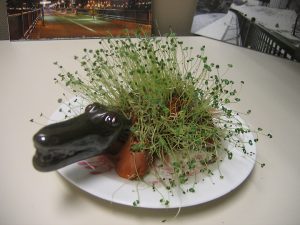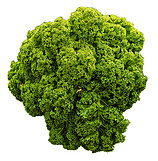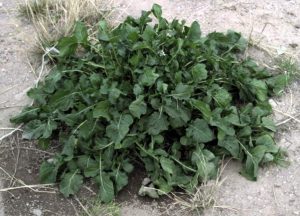Who doesn’t love easy? If you are just getting started growing your own microgreens, you will have the greatest chances of success if you begin with some of the varieties that are known for being easy to grow. (Even if you are an experienced microgreen gardener, having a few varieties of the easy ones going will allow you to focus more of your attention elsewhere – either on some of the more challenging microgreen varieties to grow, or on totally different things, like building a better chicken coop [my current personal priorities showing through.]
The Very Most Easiest
 OK, well, according to the folks at True Leaf Market, the absolute easiest microgreens to grow are chia greens. They grow so easily that you can literally grow them without soil or hydroponic growing mats. Just a hunk of terracotta with some grooves in it to hold the seeds in place, and you’re good to go. This is how, in 1977, Joe Pedott’s company Joseph Enterprises, Inc. was able to create and market a line of novelty figurines upon which chia sprouts could grow in order to represent an animal or person’s fur or hair. Ch-ch-ch-chia!
OK, well, according to the folks at True Leaf Market, the absolute easiest microgreens to grow are chia greens. They grow so easily that you can literally grow them without soil or hydroponic growing mats. Just a hunk of terracotta with some grooves in it to hold the seeds in place, and you’re good to go. This is how, in 1977, Joe Pedott’s company Joseph Enterprises, Inc. was able to create and market a line of novelty figurines upon which chia sprouts could grow in order to represent an animal or person’s fur or hair. Ch-ch-ch-chia!
As far as taste, Mandi Warbington of On The Grow describes it like this: “The taste is very strong, and I would not suggest eating this by itself, but I think if you…mixed it in with things, it would taste pretty good. It would add a very unique…citrus/tart flavor to it.” The True Leaf Market catalog describes the taste as “earthy.” I have not personally tried micro chia, and although I would be willing to if I had some right in front of me, it’s not on my Top 10 list of new microgreens I’m eager to try.
The Brassica Family
 So, taking a look at microgreens one would actually want to eat, almost without exception (actually, I haven’t yet found an exception, but I wanted to give myself room for the possibility) members of the Brassica family of vegetables can be grown as microgreens very quickly and easily. The Brassica family of vegetables is also known as the mustard family and includes mustard greens, obviously, as well as all types of radishes (China rose, daikon, hong vit, etc,) broccoli, kale, cabbage, cauliflower, collards, brussels sprouts and wasabi. There are so many different choices available just within the Brassica family, providing a broad spectrum of flavor and nutrition profiles, that it would take you quite a while (or a vast growing space) to be able to try growing them all. Brassicas tolerate cooler temperatures better than some other families of vegetables. This makes them ideal for growing during the winter months when your indoor room temperature may be a little on the cool side. (We keep our thermostat set at 60°F /15°C to conserve energy.)
So, taking a look at microgreens one would actually want to eat, almost without exception (actually, I haven’t yet found an exception, but I wanted to give myself room for the possibility) members of the Brassica family of vegetables can be grown as microgreens very quickly and easily. The Brassica family of vegetables is also known as the mustard family and includes mustard greens, obviously, as well as all types of radishes (China rose, daikon, hong vit, etc,) broccoli, kale, cabbage, cauliflower, collards, brussels sprouts and wasabi. There are so many different choices available just within the Brassica family, providing a broad spectrum of flavor and nutrition profiles, that it would take you quite a while (or a vast growing space) to be able to try growing them all. Brassicas tolerate cooler temperatures better than some other families of vegetables. This makes them ideal for growing during the winter months when your indoor room temperature may be a little on the cool side. (We keep our thermostat set at 60°F /15°C to conserve energy.)
Other Easy Microgreens
 Arugula is known for being easy to grow. In fact, arugula was my first ever seed-to-plate garden success! Most of the other salad greens (lettuce, romaine, endive, etc) will easily grow as microgreens and have the added benefit of continuing on to become baby salad greens should you decide to allow them to keep growing (for example, if you’re producing microgreens faster than you can eat them. If this is your situation, you might want to consider growing microgreens for profit, eh?)
Arugula is known for being easy to grow. In fact, arugula was my first ever seed-to-plate garden success! Most of the other salad greens (lettuce, romaine, endive, etc) will easily grow as microgreens and have the added benefit of continuing on to become baby salad greens should you decide to allow them to keep growing (for example, if you’re producing microgreens faster than you can eat them. If this is your situation, you might want to consider growing microgreens for profit, eh?)
Some microgreens grow easily in soil, but are very difficult to grow hydroponically. This is often the case with vegetables which have large or irregularly-shaped seeds, such as sunflowers or buckwheat. If you choose to grow microgreens hydroponically, do yourself a favor and make sure that you choose varieties that grow well in a hydroponic system.
“Mediums”
There are a few other microgreens which are regarded as easy to grow, but which require some special consideration. Parsley is an easy microgreen to grow, but it has a long germination period (as much as 20 days,) so it really takes some commitment to keep those seeds moist throughout that period. Corn grows easily as a microgreen, but needs to be deprived of light to keep it from developing the stringy fibers that are typically in the leaves of corn plants. Similarly, turnips will easily grow as microgreens, but prefer indirect light. Rutabaga is also rated as easy. I haven’t personally grown rutabaga microgreens before, but I would suspect that they favor similar conditions as turnips.
Curious About The Difficult Ones?
Beets, Swiss chard, chives and celery are all considered advanced, difficult or challenging. Among other factors, they tend to have germination periods that are measured in weeks rather than in days. That certainly doesn’t mean you shouldn’t grow them. It can be very satisfying to conquer a challenge. That’s why so many electronic games have a “hard mode.” Plus, you are very rarely going to be able to find these harder-to-grow varieties available for purchase, either in health food stores or farmers markets. Most of the commercial microgreens operations are going to focus on the quick and easy types to keep a steady business flow. Developing your microgreens growing skill will allow you to try new foods that are simply not available elsewhere.
Set Youself Up For Success
Growing microgreens not only results in a tasty, nutritious product, but it can also be a fun and rewarding hobby. However, nothing is fun if it’s too hard. By knowing which varieties are the easiest microgreens to grow, you can save yourself a lot of frustration, especially when you’re first getting started. Then after you’ve gained some expertise, you can turn up the difficulty level, if you desire, and take on some of the more challenging ones. (Or just keep it easy – it’s all up to you.)
***Have you tried growing microgreens? Please let me know in the Comments which ones you have (or haven’t) found to be the easiest to grow!***

This is one of my most favorite topics. I’ve just got back into growing sprouts. Wow-what a healthy lift I get each day. Still looking for the best micro-greens to grow. Your article was very helpful on my journey. Looking forward to following your posts.
Thank you. I have more experience in soil than in hydro so far, so as I continue to expand in that direction I’ll be checking out your posts as well!
I have tried for years to grow lettuce in the garden but as soon as the sun is out, they bolt right away. I did not know that I can grow salad greens as microgreens. Do you just plant the seeds directly in a pot and keep them indoors? How soon can we harvest the microgreens?
Lettuce can be harvested as microgreens as early as 14-16 days. You can take them to the baby salad stage in 21 days or so; full maturity will require them to be transplanted (to allow space to grow) and takes 35-70 days depending on variety. If you do decide to try it please come back and let me know how it goes!
Thank you very informative something I’m really interested in.If I have any questions I’ll definitely contact you.
Yes, please do!
Very inspiring post! Thank you for making it sound so doable and not nearly as scary as I would think. I’ll have to bookmark this for future reference. Thank you so much for the information.
Thanks, Adam! If you give it a try, please let me know how it goes for you.
Hi,
Well my habit of spending some time on the internet has finally paid off lol.
I loved this article, and I’m going to try growing a few of these myself. Thanks for listing which ones are difficult, I’m going to start with the easy ones as I don’t have a good track record with plants.
I’ve killed every house plant I’ve ever had, so I’m hoping that by following this, I will finally be able to grow something.
Judy
That’s wonderful to hear, Judy! Please come back and let me know how it goes!
There is certainly a lot to know about this topic. I really like all of the points you have made.
Thanks, Devin. I like the points I made too. ;->